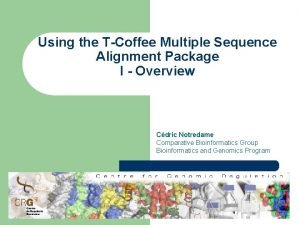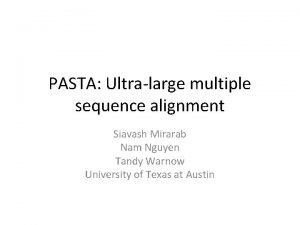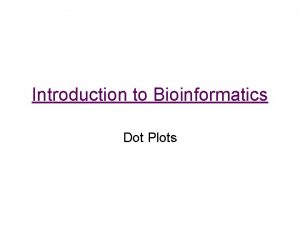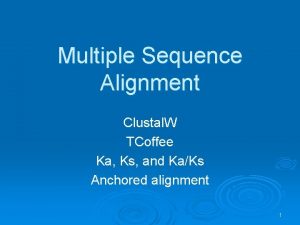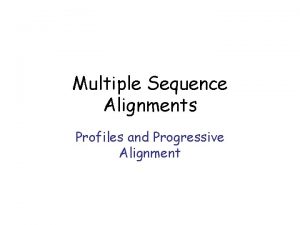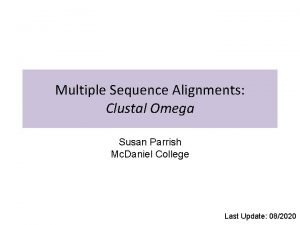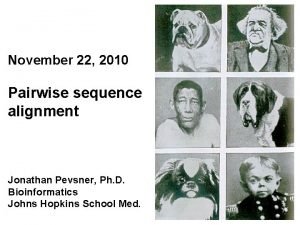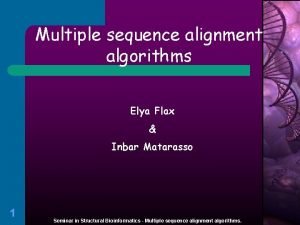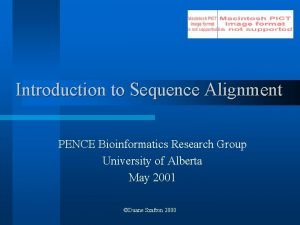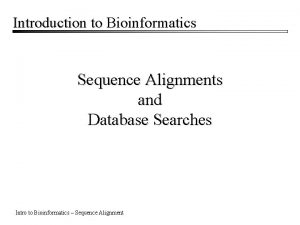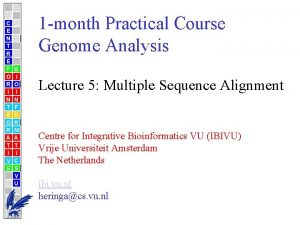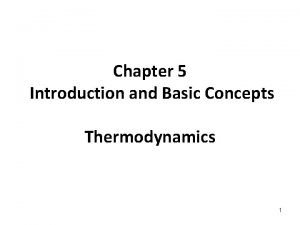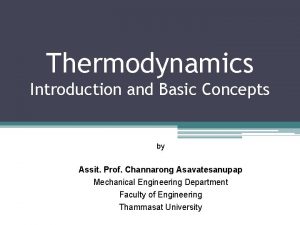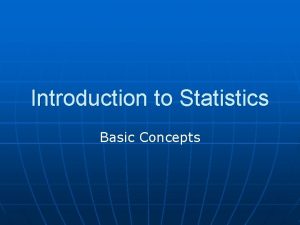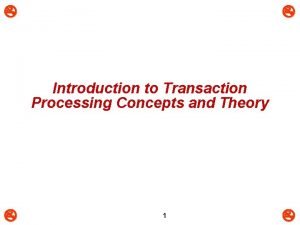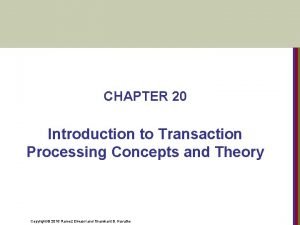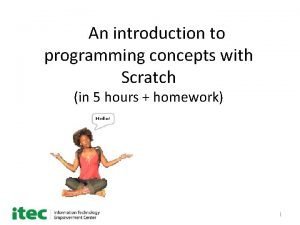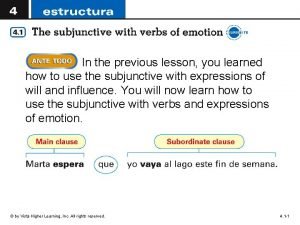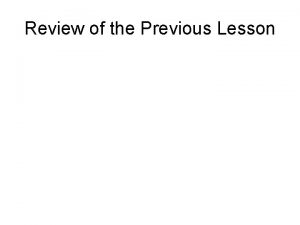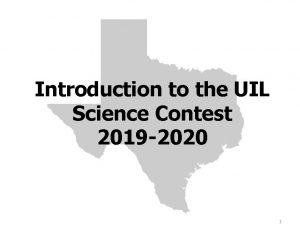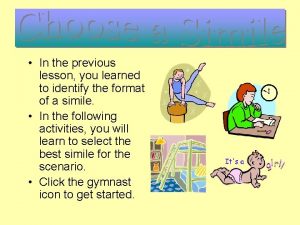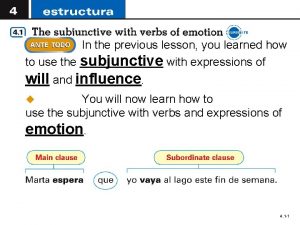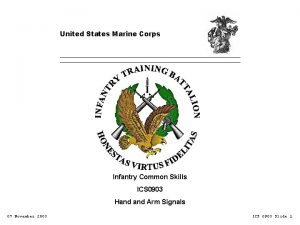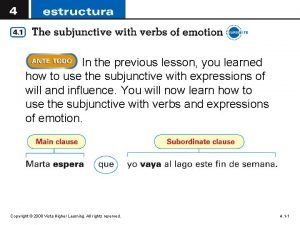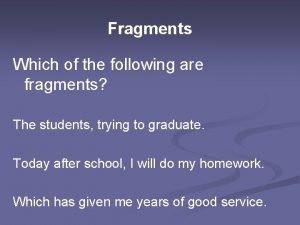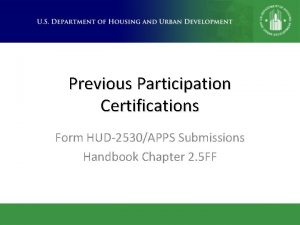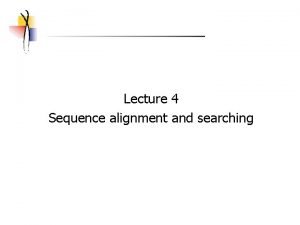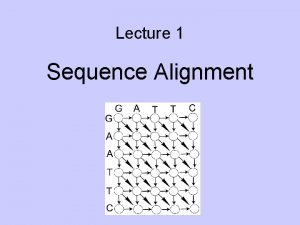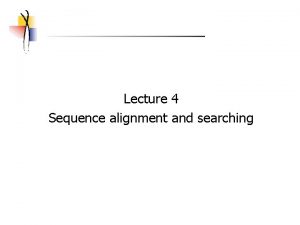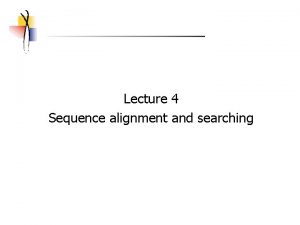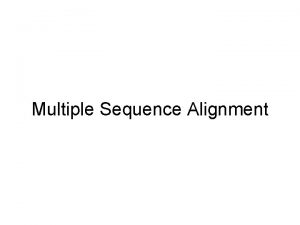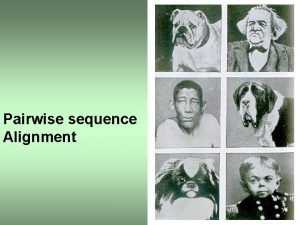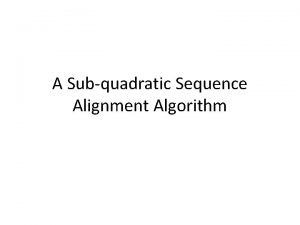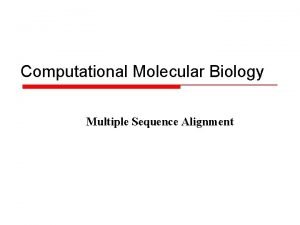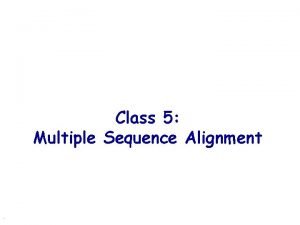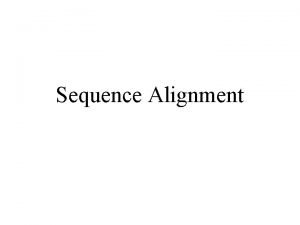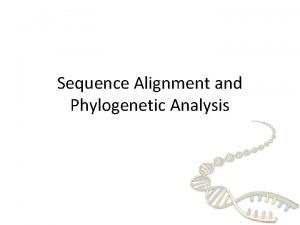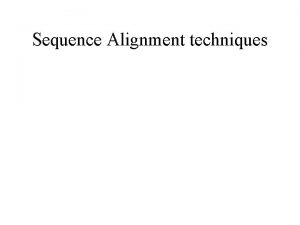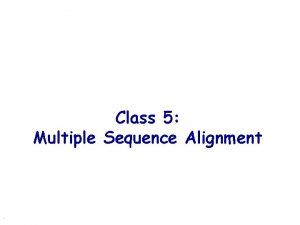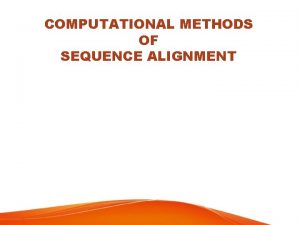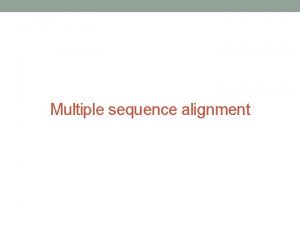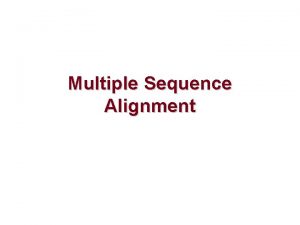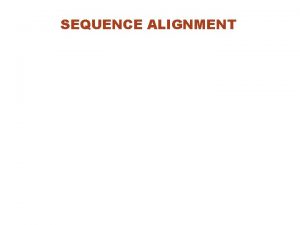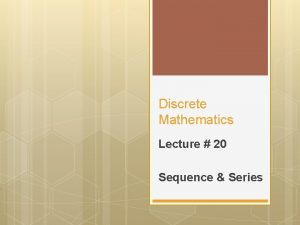Previous Lecture Sequence Alignment Concepts This Lecture Introduction


![BLAST Searches Gen. Bank (or a custom database) [BLAST= Basic Local Alignment Search Tool] BLAST Searches Gen. Bank (or a custom database) [BLAST= Basic Local Alignment Search Tool]](https://slidetodoc.com/presentation_image_h/b193480c6d835770bf71ac40ba830a21/image-3.jpg)






















![BLAST Results - Alignment >gi|17556182|ref|NP_497582. 1| Predicted CDS, phosphatidylinositol transfer protein [Caenorhabditis elegans] gi|14574401|gb|AAK BLAST Results - Alignment >gi|17556182|ref|NP_497582. 1| Predicted CDS, phosphatidylinositol transfer protein [Caenorhabditis elegans] gi|14574401|gb|AAK](https://slidetodoc.com/presentation_image_h/b193480c6d835770bf71ac40ba830a21/image-26.jpg)





















- Slides: 47

Previous Lecture: Sequence Alignment Concepts

This Lecture Introduction to Biostatistics and Bioinformatics Sequence Database Searching Stuart M. Brown, Ph. D. Center for Health Informatics and Bioinformatics NYU School of Medicine
![BLAST Searches Gen Bank or a custom database BLAST Basic Local Alignment Search Tool BLAST Searches Gen. Bank (or a custom database) [BLAST= Basic Local Alignment Search Tool]](https://slidetodoc.com/presentation_image_h/b193480c6d835770bf71ac40ba830a21/image-3.jpg)
BLAST Searches Gen. Bank (or a custom database) [BLAST= Basic Local Alignment Search Tool] The NCBI BLAST web server lets you compare your query sequence to various sections of Gen. Bank: – nr = non-redundant (main sections) – month = new sequences from the past few weeks – ESTs – human, drososphila, yeast, or E. coli genomes – proteins (by automatic translation) • This is a VERY fast and powerful computer.

BLAST • Uses word matching • Similarity matching of words (3 aa’s, 11 bases) – does not require identical words. • If no words are similar, then no alignment – won’t find matches for very short sequences • “gapped BLAST” (BLAST 2) improved handling of gaps in alignment • BLAST searches can be sent to the NCBI’s server from website, or a custom client program (Unix)

BLAST Algorithm

BLAST Word Matching MEAAVKEEISVEDEAVDKNI MEA EAA AAV AVK VKE KEE EEI EIS ISV. . . Break query into words: Break database sequences into words:

Michael Schatz

Michael Schatz

Compare Word Lists Database Sequence Word Lists Query Word List: MEA EAA AAV AVK VKL KEE EEI EIS ISV ? Compare word lists by Hashing (allow near matches) RTT SDG SRW QEL VKI DKI LFC AAV PFR … AAQ KSS LLN RWY GKG NIS WDV KVR DEI …

Find locations of matching words in database sequences ELEPRRPRYRVPDVLVADPPIARLSVSGRDENSVELTMEAT MEA EAA AAV AVK KLV KEE EEI EIS ISV TDVRWMSETGIIDVFLLLGPSISDVFRQYASLTGTQALPPLFSLGYHQSRWNY IWLDIEEIHADGKRYFTWDPSRFPQPRTMLERLASKRRVKLVAIVDPH

Extend hits one base at a time

BLAST 2 algorithm • The NCBI’s BLAST website and GCG (NETBLAST) now both use BLAST 2 (also known as “gapped BLAST”) • This algorithm is more complex than the original BLAST • It requires two word matches close to each other on a pair of sequences (i. e. with a gap) before it creates an alignment

Gapped BLAST Seq_XYZ: Query: HVTGRSAF_FSYYGYGCYCGLGTGKGLPVDATDRCC QSVFDYIYYGCYCGWGLG_GK__PRDA E-val=10 -13 • Use two word matches as anchors to build an alignment between the query and a database sequence. • Then score the alignment.

HSPs are Aligned Regions • The results of the word matching and attempts to extend the alignment are segments - called HSPs (High-scoring Segment Pairs) • BLAST often produces several short HSPs rather than a single aligned region

• • >gb|BE 588357. 1|BE 588357 194087 BARC 5 BOV Bos taurus c. DNA 5'. Length = 369 • Score = 272 bits (137), • • • • • • Identities = 258/297 (86%), Gaps = 1/297 (0%) Strand = Plus / Plus Expect = 4 e-71 Query: 17 aggatccaacgtcgctccagctgctcttgacgactccacagataccccgaagccatggca 76 |||||||| || | ||||| Sbjct: 1 aggatccaacgtcgctgcggctacccttaaccact-cgcagaccccccgcagccatggcc 59 Query: 77 agcaagggcttgcaggacctgaagcaacaggtggaggggaccgcccaggaagccgtgtca 136 |||||||||||| | |||||| || Sbjct: 60 agcaagggcttgcaggacctgaagaagcaagtggagggggcggcccaggaagcggtgaca 119 Query: 137 gcggccggagcggcagctcagcaagtggtggaccaggccacagaggcggggcagaaagcc 196 |||| | ||||||||| || |||||| Sbjct: 120 tcggccggaacagcggttcagcaagtggtggatcaggccacagaagcagggcagaaagcc 179 Query: 197 atggaccagctggccaagaccacccaggaaaccatcgacaagactgctaaccaggcctct 256 ||||| | ||||||||||||| Sbjct: 180 atggaccaggttgccaagactacccaggaaaccatcgaccagactgctaaccaggcctct 239 Query: 257 gacaccttctctgggattgggaaaaaattcggcctcctgaaatgacagcagggagac 313 || || ||||||||| |||| Sbjct: 240 gagactttctcgggttttgggaaaaaacttggcctcctgaaatgacagaagggagac 296


Similarity Search Statistics • Homework searches with Needleman-Wunsch and Smith-Waterman have shown problems with “score” functions • Score varies with length of sequences, gap penalties, composition, protein scoring matrix, etc. • Need an unbiased method to compare alignemnts and judge if they are “significant” in a biological sense

How to score alignments? • In a large database search, the scores of good alignments differ from random alignments. • Many are random, very few good ones. • This follows an extreme value distribution, not a normal distribution. So we need to use an appropriate statistical test.

Normal vs. Extreme Value Distributions

Pearson: FASTA Statistics • http: //people. virginia. edu/~wrp/talk 95/prot_talk 12 -95_4. html

Compute p-value from the extreme value distribution E is the e-value (significance score, m is your query length, n is the length of a matching database sequence, S is the score (computed from a count of matching letters with a scoring matrix and gap penalty). K is a constant computed from the database size, lambda is a constant that models the scoring system.

BLAST Statistics • E() value is equivalent to a p value • Significant if E() < 0. 05 (smaller numbers are more significant) – The E-value represents the likelihood that the observed alignment is due to chance alone. A value of 1 indicates that an alignment this good would happen by chance with any random sequence searched against this database. The official NCBI explanation of BLAST statistics by Stephen Altschul http: //www. ncbi. nlm. nih. gov/BLAST/tutorial/Altschul-1. html

BLAST has Automatic Translation • BLASTX makes automatic translation (in all 6 reading frames) of your DNA query sequence to compare with protein databanks • TBLASTN makes automatic translation of an entire DNA database to compare with your protein query sequence • Only make a DNA-DNA search if you are working with a sequence that does not code for protein.

BLAST Results - Summary

BLAST Results - List
![BLAST Results Alignment gi17556182refNP497582 1 Predicted CDS phosphatidylinositol transfer protein Caenorhabditis elegans gi14574401gbAAK BLAST Results - Alignment >gi|17556182|ref|NP_497582. 1| Predicted CDS, phosphatidylinositol transfer protein [Caenorhabditis elegans] gi|14574401|gb|AAK](https://slidetodoc.com/presentation_image_h/b193480c6d835770bf71ac40ba830a21/image-26.jpg)
BLAST Results - Alignment >gi|17556182|ref|NP_497582. 1| Predicted CDS, phosphatidylinositol transfer protein [Caenorhabditis elegans] gi|14574401|gb|AAK 68521. 1|AC 024814_1 Hypothetical protein Y 54 F 10 AR. 1 [Caenorhabditis elegans] Length = 336 Score = 283 bits (723), Expect = 8 e-75 Identities = 144/270 (53%), Positives = 186/270 (68%), Gaps = 13/270 (4%) Query: 48 Sbjct: 70 KEYRVILPVSVDEYQVGQLYSVAEASKNXXXXXXXPYEK----DGE--KGQYT 101 K+ RV+LP+SV+EYQVGQL+SVAEASK P++ +G+ KGQYT KKSRVVLPMSVEEYQVGQLWSVAEASKAETGGGEGVEVLKNEPFDNVPLLNGQFTKGQYT 129 Query: 102 HKIYHLQSKVPTFVRMLAPEGALNIHEKAWNAYPYCRTVITN-EYMKEDFLIKIETWHKP 160 HKIYHLQSKVP +R +AP+G+L IHE+AWNAYPYC+TV+TN +YMKE+F +KIET H P Sbjct: 130 HKIYHLQSKVPAILRKIAPKGSLAIHEEAWNAYPYCKTVVTNPDYMKENFYVKIETIHLP 189 Query: 161 DLGTQENVHKLEPEAWKHVEAVYIDIADRSQVL-SKDYKAEEDPAKFKSIKTGRGPLGPN 219 D GT EN H L+ + E V I+IA+ + L S D + P+KF+S KTGRGPL N Sbjct: 190 DNGTTENAHGLKGDELAKREVVNINIANDHEYLNSGDLHPDSTPSKFQSTKTGRGPLSGN 249 Query: 220 WKQELVNQKDCPYMCAYKLVTVKFKWWGLQNKVENFIHKQERRLFTNFHRQLFCWLDKWV 279 WK + P MCAYKLVTV FKW+G Q VEN+ H Q RLF+ FHR++FCW+DKW Sbjct: 250 WKDSVQ-----PVMCAYKLVTVYFKWFGFQKIVENYAHTQYPRLFSKFHREVFCWIDKWH 304 Query: 280 DLTMDDIRRMEEETKRQLDEMRQKDPVKGM 309 LTM DIR +E + +++L+E R+ V+GM Sbjct: 305 GLTMVDIREIEAKAQKELEEQRKSGQVRGM 334

BLAST alignments are short segments • BLAST tends to break alignments into nonoverlapping segments • can be confusing • reduces overall significance score

BLAST is Approximate • BLAST makes similarity searches very quickly because it takes shortcuts. – looks for short, nearly identical “words” (11 bases) • It also makes errors – misses some important similarities – makes many incorrect matches • easily fooled by repeats or skewed composition

Web BLAST runs on a big computer at NCBI • Usually fast, but does get busy sometimes • Fixed choices of databases – problems with genome data “clogging” the system – ESTs are not part of the default “NR” dataset • Uses filtering of repeats • Graphical summary of output • Links to Gen. Bank sequences

BLAST Statistics • E() value is equivalent to standard P value • Significant if E() < 0. 05 (smaller numbers are more significant) – The E-value represents the likelihood that the observed alignment is due to chance alone. A value of 1 indicates that an alignment this good would happen by chance with any random sequence searched against this database.

Interpretation of output • very low E() values (e-100) are homologs or identical genes • moderate E() values are related genes • long list of gradually declining of E() values indicates a large gene family • long regions of moderate similarity are more significant than short regions of high identity

What program to use for searching? 1) Smith-Waterman is slower, but more sensitive – known as a “rigorous” or “exhaustive” search = optimal alignments – EMBOSS “water” program 2) FASTA – more sensitive for DNA-DNA comparisons – FASTX and TFASTX can find similarities in sequences with frameshifts 3) BLAST is fastest and easily accessed on the Web – limited sets of databases for web version – Free software to install on UNIX computers, make custom databases – nice translation tools (BLASTX, TBLASTN)

Borderline similarity • What to do with matches with E() values in the 0. 5 -1. 0 range? • this is the “Twilight Zone” • retest these sequences and look for related hits (not just your original query sequence) • similarity is transitive: if A~B and B~C, then A~C

Biological Relevance • It is up to you, the biologist to scrutinize these alignments and determine if they are significant. • Were you looking for a short region of nearly identical sequence or a larger region of general similarity? • Are the mismatches conservative ones? • Are the matching regions important structural components of the genes or just introns and flanking regions?

Database to Search • The biggest factor that affects the results of a similarity search, is …obviously… what database you search • Choose to search PROTEIN databases whenever possible – Smaller = less redundant = higher e-values – Non-identical letters have information (scoring matrix)

Comprehensive vs Annotated • It is NOT always best to search the biggest, most comprehensive database • What have you learned when your cloned sequence matches a "hypothetical gene? " • Ref. Seq is the best annotated DNA database • Swiss. Prot is the best annotated protein database

What are you looking for? • Usually you want to search annotated genes • If you don't find anything, you might want to search ESTs (sequences of m. RNA fragments) • ESTs are not included in the default "nr" Gen. Bank database

Limit by species • If you know your sequence is from one species • Or you want to limit your search to just that species… • use the ENTREZ limits feature


Filters • BLAST is easily fooled by repeats and low complexity sequence (enriched in a few letters = DNA microsatellites, common acidic, basic or proline-rich regions in proteins) • Default filters remove low complexity from protein searches and known repeats (ie. Alu) from DNA searches • Removes the problem sequences before running the BLAST search • By default, filters are removed in final alignment (“lookup only”)

Size Matters • Short sequences can't get good e-values • What is the probability of finding a 12 base fragment in a "random" genome? 412 = 16, 777, 216 (once per 16 million bases) • What length DNA fragment is needed to define a unique location in the genome? 416 = 4, 294, 967, 296 (4 billion bases) • So, what is the best e-value you can get for a 16 base fragment?

Word size • BLAST uses a default word size of 11 bases for DNA • Short sequences will have few words • Low quality sequence might have a sequencing error in every word • "Mega. Blast" uses very large words (28) – allows for fast m. RNA > genome alignment – allows huge sequences to be use as query • "Search for short, nearly exact matches" • word size = 7, expect = 1000

Batch BLAST • What if you need to do a LOT of BLAST searches? • NCBI www BLAST server will accept a FASTA file with multiple sequences • NCBI has a BLAST client program: blastcl 3 (Unix, Windows, and Mac) • NETBLAST is a scriptable BLAST client in GCG package

Lots of Results • Batch or acclerated BLAST searches produce lots of results files. • What to do with them? • Blast. Report 2 is a Perl script from NCBI to sort out results from a batch BLAST. "Blast. Report 2 is a perl script that reads the output of Blastcl 3, reformats it for ease of use and eliminates useless information. "

BLAST Parser • Hundreds of different people have written programs to sort BLAST results (including myself) • Better to use a common code base • Bio. Perl is a collection of public Perl modules including several BLAST parsers

You are now eligible to test for your black belt in BLAST

Next Lecture: Distributions
 Compare two sequences
Compare two sequences Difference between local and global alignment
Difference between local and global alignment Global alignment vs local alignment
Global alignment vs local alignment Semi global alignment
Semi global alignment Global vs local alignment
Global vs local alignment Tcoffee alignment
Tcoffee alignment Pasta multiple sequence alignment
Pasta multiple sequence alignment Bioedit software free download
Bioedit software free download Dot plot sequence alignment
Dot plot sequence alignment Emboss clustal omega
Emboss clustal omega Progressive alignment
Progressive alignment Clustal omega symbols
Clustal omega symbols The sequence of statements inside a function definition
The sequence of statements inside a function definition Sequence alignment
Sequence alignment Sequence alignment
Sequence alignment Hirschberg's algorithm
Hirschberg's algorithm Actcg
Actcg Praline multiple sequence alignment
Praline multiple sequence alignment 01:640:244 lecture notes - lecture 15: plat, idah, farad
01:640:244 lecture notes - lecture 15: plat, idah, farad Nucleotide sequence vs amino acid sequence
Nucleotide sequence vs amino acid sequence Pseudocode sequence
Pseudocode sequence The difference between will and going to
The difference between will and going to Convolutional sequence to sequence learning
Convolutional sequence to sequence learning Introduction and basic concepts of thermodynamics
Introduction and basic concepts of thermodynamics Thermodynamics introduction and basic concepts
Thermodynamics introduction and basic concepts Introduction to statistics and some basic concepts
Introduction to statistics and some basic concepts Introduction to marketing concepts
Introduction to marketing concepts Introduction to transaction processing concepts and theory
Introduction to transaction processing concepts and theory Introduction and mathematical concepts
Introduction and mathematical concepts Introduction and mathematical concepts
Introduction and mathematical concepts Introduction to transaction processing concepts and theory
Introduction to transaction processing concepts and theory Scratch programming concepts
Scratch programming concepts Introduction to biochemistry lecture notes
Introduction to biochemistry lecture notes Introduction to psychology lecture
Introduction to psychology lecture Introduction to algorithms lecture notes
Introduction to algorithms lecture notes Previous owner of oregon country
Previous owner of oregon country What you learned in the previous lesson
What you learned in the previous lesson Value received and value parted with
Value received and value parted with Uil science
Uil science In the previous lesson i learned that
In the previous lesson i learned that From your previous lesson you have learned
From your previous lesson you have learned Disregard previous command hand and arm signal
Disregard previous command hand and arm signal In our previous lesson i have learned about
In our previous lesson i have learned about Based on the following examples (previous fragments)
Based on the following examples (previous fragments) Based on the following examples (previous fragments)
Based on the following examples (previous fragments) What was the overall effect of metternich's plan on france
What was the overall effect of metternich's plan on france Hud 2530
Hud 2530 Logo smk taman nusa damai
Logo smk taman nusa damai





